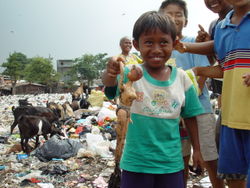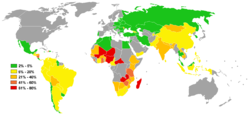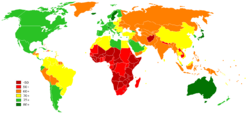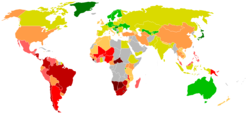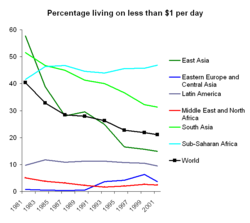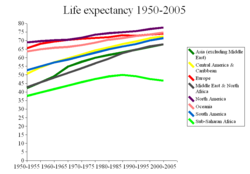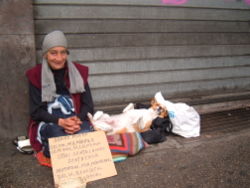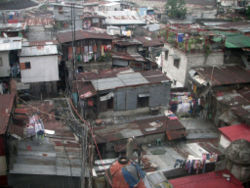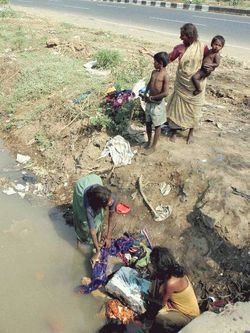Poverty
2007 Schools Wikipedia Selection. Related subjects: Animal & Human Rights; Culture and Diversity
Poverty is a condition in which a person or community is deprived of, and or lacks the essentials for a minimum standard of well-being and life. Since poverty is understood in many senses, these essentials may be material resources such as food, safe drinking water, and shelter, or they may be social resources such as access to information, education, health care, social status, political power, or the opportunity to develop meaningful connections with other people in society.
Poverty may also be defined in relative terms. In this view income disparities or wealth disparities are seen as an indicator of poverty and the condition of poverty is linked to questions of scarcity and distribution of resources and power.
Poverty may be defined by a government or organization for legal purposes, see Poverty threshold.
Poverty may be seen as the collective condition of poor people, or of poor groups, and in this sense entire nation-states are sometimes regarded as poor. A more neutral term is developing nations. Although the most severe poverty is in the developing world, there is evidence of poverty in every region. In developed countries examples include homeless people and ghettos.
Poverty is also a type of religious vow, a state that may be taken on voluntarily in keeping with practices of piety.
Measuring poverty
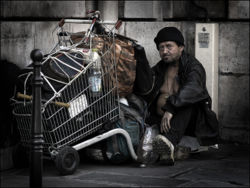
When measured, poverty may be absolute or relative poverty. Absolute poverty refers to a set standard which is consistent over time and between countries. An example of an absolute measurement would be the percentage of the population eating less food than is required to sustain the human body (approximately 2000-2500 calories per day for an adult male).
The World Bank defines extreme poverty as living on less than US$ ( PPP) 1 per day, and moderate poverty as less than $2 a day. It has been estimated that in 2001, 1.1 billion people had consumption levels below $1 a day and 2.7 billion lived on less than $2 a day. The proportion of the developing world's population living in extreme economic poverty has fallen from 28 percent in 1990 to 21 percent in 2001. Much of the improvement has occurred in East and South Asia. In Sub-Saharan Africa GDP/capita shrank with 14 percent and extreme poverty increased from 41 percent in 1981 to 46 percent in 2001. Other regions have seen little or no change. In the early 1990s the transition economies of Europe and Central Asia experienced a sharp drop in income. Poverty rates rose to 6 percent at the end of the decade before beginning to recede. There are various criticisms of these measurements.
Other indicators are also improving. Life expectancy has greatly increased in the developing world since WWII and is starting to close the gap to the developed world where the improvement has been smaller. Even in Sub-Saharan Africa, the least developed region, life expectancy increased from 30 years before World War II to a peak of about 50 years before the HIV pandemic and other diseases started to force it down to the current level of 47 years. Child mortality has decreased in every developing region of the world. The proportion of the world's population living in countries where per-capita food supplies are less than 2,200 calories (9,200 kilojoules) per day decreased from 56% in the mid-1960s to below 10% by the 1990s. Between 1950 and 1999, global literacy increased from 52% to 81% of the world. Women made up much of the gap: Female literacy as a percentage of male literacy has increased from 59% in 1970 to 80% in 2000. The percentage of children not in the labor force has also risen to over 90% in 2000 from 76% in 1960. There are similar trends for electric power, cars, radios, and telephones per capita, as well as the proportion of the population with access to clean water.
Relative poverty views poverty as socially defined and dependent on social context. In this case, the number of people counted as poor could increase while their income rise. A relative measurement would be to compare the total wealth of the poorest one-third of the population with the total wealth of richest 1% of the population. There are several different income inequality metrics. One example is the Gini coefficient.
In many developed countries the official definition of poverty used for statistical purposes is based on relative income. As such many critics argue that poverty statistics measure inequality rather than material deprivation or hardship. For instance, according to the U.S. Census Bureau, 46% of those in "poverty" in the U.S. own their own home (with the average poor person's home having three bedrooms, with one and a half baths, and a garage). Furthermore, the measurements are usually based on a person's yearly income and frequently take no account of total wealth. The main poverty line used in the OECD and the European Union is based on "economic distance", a level of income set at 50% of the median household income. The US poverty line is more arbitrary. It was created in 1963-64 and was based on the dollar costs of the U.S. Department of Agriculture's "economy food plan" multiplied by a factor of three. The multiplier was based on research showing that food costs then accounted for about one third of the total money income. This one-time calculation has since been annually updated for inflation.
Income inequality for the world as a whole is diminishing. A 2002 study by Xavier Sala-i-Martin finds that this is driven mainly, but not fully, by the extraordinary growth rate of the incomes of the 1.2 billion Chinese citizens. However, unless Africa achieve economic growth, then China, India, the OECD and the rest of middle-income and rich countries will diverge away from it, and global inequality will rise. Thus, the economic growth of the African continent should be the priority of anyone concerned with increasing global income inequality.
Even if poverty may be lessening for the world as a whole, it continues to be an enormous problem:
- One third of deaths - some 18 million people a year or 50,000 per day - are due to poverty-related causes. That's 270 million people since 1990, the majority women and children, roughly equal to the population of the US.
- Every year nearly 11 million children die before their fifth birthday.
- In 2001, 1.1 billion people had consumption levels below $1 a day and 2.7 billion lived on less than $2 a day
- 800 million people go to bed hungry every day.
The World Bank's "Voices of the Poor" , based on research with over 20,000 poor people in 23 countries, identifies a range of factors which poor people consider elements of poverty. Most important are those necessary for material well-being, especially food. Many others relate to social rather than material issues.
- precarious livelihoods
- excluded locations
- gender relationships
- problems in social relationships
- lack of security
- abuse by those in power
- dis-empowering institutions
- limited capabilities, and
- weak community organizations.
Causes of poverty
Many different factors have been cited to explain why poverty occurs. However, no single explanation has gained universal acceptance. Some possible factors include:
- Natural factors such as the climate or environment
- Geographic factors, for example access to fertile land, fresh water, minerals, energy, and other natural resources. Presence or absence of natural features helping or limiting communication, such mountains, deserts, sailable rivers, or coastline. Historically, geography has prevented or slowed the spread of new technology to areas such as the Americas and Sub-Saharan Africa. The climate also limits what crops and farm animals may be used on similarly fertile lands.
- On the other hand, research on the resource curse has found that countries with an abundance of natural resources creating quick wealth from exports tend to have less long-term prosperity than countries with less of these natural resources.
- Inadequate nutrition in childhood in poor nations may lead to physical and mental stunting that, in turn, may lead to economic problems. (Hence, it is both a cause and an effect). For example, lack of both iodine and iron has been implicated in impaired brain development, and this can affect enormous numbers of people: it is estimated that 2 billion people (one-third of the total global population) are affected by iodine deficiency, including 285 million 6- to 12-year-old children. In developing countries, it is estimated that 40% of children aged 4 and under suffer from anaemia because of insufficient iron in their diets. See also Health and intelligence.
- Disease, specifically diseases of poverty: AIDS, malaria, and tuberculosis and others overwhelmingly afflict developing nations, which perpetuate poverty by diverting individual, community, and national health and economic resources from investment and productivity. Further, many tropical nations are affected by parasites like malaria, schistosomiasis, and trypanosomiasis that are not present in temperate climates. The Tsetse fly makes it very difficult to use many animals in agriculture in afflicted regions.
- Poverty itself, prevents (for example) various forms of investment
- Inability to find a well-paying job (see working poor)
- Unemployment and/or underemployment
- Globalization, too much or too little.
- Lacking rule of law.
- Lacking democracy.
- Lacking infrastructure.
- Lacking health care.
- Lacking education.
- Government corruption.
- Overpopulation and lack of access to birth control methods. Note that population growth slows or even become negative as poverty is reduced due to the demographic transition.
- Tax havens which tax their own citizens and companies but not those from other nations and refuse to disclose information necessary for foreign taxation. This enables large scale political corruption, tax evasion, and organized crime in the foreign nations.
- Historical factors, for example imperialism and colonialism.
- Capitalism, Socialism, Communism, Monarchy, Fascism and Totalitarianism have all been named as causes by scholars writing from different perspectives. For example, poorly functioning property rights is seen by some as a cause of poverty, while socialists see the institution of property rights itself as a cause of poverty.
- Lacking free trade. In particular, the very high subsidies to and protective tariffs for agriculture in the developed world. For example, almost half of the budget of the European Union goes to agricultural subsidies, mainly to large farmers and agribusinesses, which form a powerful lobby. Japan gave 47 billion dollars in 2005 in subsidies to its agricultural sector, nearly four times the amount it gave in total foreign aid. The US gives 3.9 billion dollars each year in subsidies to its cotton sector, including 25,000 growers, three times more in subsidies than the entire USAID budget for Africa’s 500 million people. This drains the taxed money and increases the prices for the consumers in developed world; decreases competition and efficiency; prevents exports by more competitive agricultural and other sectors in the developed world due to retaliatory trade barriers; and undermines the very type of industry in which the developing countries do have comparative advantages.
- Lack of freedom and social oppression.
- Lack of social integration. For example, arising from immigration (see related article, Economic impact of immigration to Canada).
- Slavery
- Crime, both white-collar crime and blue-collar crime.
- Substance abuse, such as alcoholism and drug abuse.
- War, including civil war, genocide, and democide.
- Brain drain
- Lack of social skills.
- Exploitation of the poor by the rich.
- Even if not exploitation in the sense of theft, the already wealthy may have easier to accumulate more wealth, for example by hiring better financial advisors.
- Matthew effect: the phenomenon, widely observed across advanced welfare states, that the middle classes tend to be the main beneficiaries of social benefits and services, even if these are primarily targeted at the poor.
- Cultural causes, which attribute poverty to common patterns of life, learned or shared within a community. For example, Max Weber argued that Protestantism contributed to economic growth during the industrial revolution.
- Individual beliefs, actions and choices.
- Mental illness and disability
- Discrimination of various kinds, such as age discrimination, gender discrimination, racial discrimination.
Effects of poverty
Some effects of poverty may also be causes, as listed above, thus creating a " poverty cycle" and complicating the subject further:
- Depression
- Lack of sanitation.
- Increased vulnerability to natural disasters
- Extremism
- Hunger and starvation
- Human trafficking
- High crime rate
- Increased suicides
- Increased risk of political violence; such as terrorism, war and genocide
- Homelessness
- Lack of opportunities for employment
- Low literacy
- Social isolation
- Loss of population due to emigration.
- Increased discrimination
- Lower life expectancy
- Drug abuse
Poverty reduction
In politics, the fight against poverty is usually regarded as a social goal and many governments have — secondarily at least — some dedicated institutions or departments.
Economic growth

- The anti-poverty strategy of the World Bank depends heavily on reducing poverty through the promotion of economic growth. However, some consider this approach does not actively or directly work to reduce or eliminate poverty. The World Bank argues that an overview of many studies show that:
- Growth is fundamental for poverty reduction, and in principle growth as such does not affect inequality.
- Growth accompanied by progressive distributional change is better than growth alone.
- High initial income inequality is a brake on poverty reduction.
- Poverty itself is also likely to be a barrier for poverty reduction; and wealth inequality seems to predict lower future growth rates.
- The Global Competitiveness Report, the Ease of Doing Business Index, and the Index of Economic Freedom are annual reports, often used in academic research, ranking the worlds nations on factors argued to increase economic growth and reduce poverty.
- Business groups see the reduction of barriers to the creation of new businesses , or reducing barriers for existing business, as having the effect of bringing more people into the formal economy.
- The 2007 World Bank report "Global Economic Prospects" predicts that in 2030 the number living on less than the equivalent of $1 a day will fall by half, to about 550 million. An average resident of what we used to call the Third World will live about as well as do residents of the Czech or Slovak republics today. However, much of Africa will have difficulty keeping pace with the rest of the developing world and even if conditions there improve in absolute terms, the report warns, Africa in 2030 will be home to a larger proportion of the world's poorest people than it is today. However, economic growth has increased rapidly in Africa after the year 2000.
Direct aid
- The government can directly help those in need. This has been applied with mixed results in most Western societies during the 20th century in what became known as the welfare state. Especially for those most at risk, such as the elderly and people with disabilities. The help can be for example monetary or food aid.
- Private charity. This is often formally encouraged within the legal system. For example, charitable trusts and tax deductions for charity.
- The Copenhagen Consensus is a listing of the most cost-effective methods for advancing global welfare.
Improving the social environment and abilities of the poor
- Subsidized housing development and urban regeneration.
- Subsidized education.
- Subsidized health care.
- Assistance in finding employment.
- Subsidized employment (see also Workfare).
- Encouragement of political participation and community organizing.
- Community practice social work.
Millennium Development Goals
Eradication of extreme poverty and hunger by 2015 is a Millennium Development Goal. In addition to broader approaches, the Sachs Report (for the UN Millennium Project) proposes a series of "quick wins", approaches identified by development experts which would cost relatively little but could have a major constructive effect on world poverty. The quick wins are:
- Access to information on sexual and reproductive health.
- Action against domestic violence.
- Appointing government scientific advisors in every country.
- Basic Income Guarantee
- Citizen's Dividend
- Deworming school children in affected areas.
- Drugs for AIDS, tuberculosis, and malaria.
- Eliminating school fees.
- Ending user fees for basic health care in developing countries.
- Free school meals for schoolchildren.
- Legislation for women’s rights, including rights to property.
- Negative Income Tax
- Planting trees.
- Providing soil nutrients to farmers in sub-Saharan Africa.
- Providing mosquito nets.
- Access to electricity, water and sanitation.
- Supporting breast-feeding.
- Training programs for community health in rural areas.
- Upgrading slums, and providing land for public housing.
Development aid
Most developed nations give some development aid to developing nations. The UN target for development aid is 0.7% of GDP; currently only a few nations achieve this. Some think tanks and NGOs have argued, however, that Western monetary aid often only serves to increase poverty and social inequality, either because it is conditioned with the implementation of harmful economic policies in the recipient countries , or because it's tied with the importing of products from the donor country over cheaper alternatives, or because foreign aid is seen to be serving the interests of the donor more than the recipient. Critics also argue that much of the foreign aid is stolen by corrupt governments and officials and that higher aid levels erode the quality of governance. Policy become much more oriented toward what will get more aid money than it does towards meeting the needs of the people.
Supporters argue that these problems may be solved with better audit of how the aid is used. Aid from non-governmental organizations may be more effective than governmental aid; this may be because it is better at reaching the poor and better controlled at the grassroots level. The Borgen Project, an anti-poverty advocacy organization, estimates the annual cost of eliminating starvation and malnutrition globally at $19 billion a year. As a point of comparison, the annual world military spending is over $1000 billion.
Other approaches
Some argue for a radical change of the economic system. There are several proposals for a fundamental restructuring of existing economic relations, and many of their supporters argue that their ideas would reduce or even eliminate poverty entirely if they were implemented. Such proposals have been put forward by both left-wing and right-wing groups: socialism, communism, anarchism, libertarianism, binary economics and participatory economics, among others.
Inequality can be reduced by progressive taxation, wealth tax, and inheritance tax.
In law, there has been a movement to seek to establish the absence of poverty as a human right.
The IMF and member countries have produced Poverty Reduction Strategy papers or PRSPs.
In his book "The End of Poverty", a prominent economist named Jeffrey Sachs laid out a plan to eradicate global poverty by the year 2025. Following his recommendations, international organizations such as the Global Solidarity Network are working to help eradicate poverty worldwide with intervention in the areas of housing, food, education, basic health, agricultural inputs, safe drinking water, transportation and communications.
The Poor People's Economic Human Rights Campaign is an organization in the United States working to secure freedom from poverty for all by organizing the poor themselves. The Campaign believes that a human rights framework, based on the value of inherent dignity and worth of all persons, offers the best means by which to organize for a political solution to poverty.
Religious poverty

Among some groups, in particular religious groups, poverty is considered a necessary or desirable condition, which must be embraced in order to reach certain spiritual, moral, or intellectual states. Poverty is often understood to be an essential element of renunciation among Buddhists and Jains, whilst in Roman Catholicism it is one of the evangelical counsels, and taken as a vow among certain religious orders. The way poverty is understood among these orders takes a variety of forms. For example, the Franciscan orders have traditionally forgone all individual and corporate forms of ownership. However, while individual ownership of goods and wealth is forbidden for Benedictines, following the Rule of St. Benedict, the monastery itself may possess both goods and money, and through history some monasteries have become very rich indeed.
In this context of religious vows, poverty may be understood as a means of self-denial in order to place oneself at the service of others; Pope Honorius III wrote in 1217 that the Dominicans "lived a life of voluntary poverty, exposing themselves to innumerable dangers and sufferings, for the salvation of others". However, following Jesus' warning that riches can be like thorns that choke up the good seed of the word (Matthew 13:22), voluntary poverty is often understood by Christians as of benefit to the individual - a form of self-discipline by which one distances oneself from distractions from God.
Etymology
The words "poverty" and "poor" came from Latin pauper = "poor", which originally came from pau- and the root of pario, i.e. "giving birth to not much" and referred to unproductive farmland or livestock.
